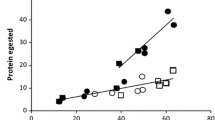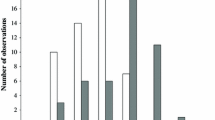Abstract
Euphydryas chalcedona prediapause larvae were reared on fertilized and control shrubs of the host plant,Diplacus aurantiacus. Larval growth was enhanced by high leaf nitrogen content and inhibited by high leaf phenolic resin content. Larvae fed less on leaves near the branch tip which contained a higher leaf resin content. The results agree with prior laboratory investigation that the dietary content of nitrogen andD. aurantiacus leaf resin are major determinants ofE. chalcedona larval growth and suggest that the phenolic leaf resin ofDiplacus may both deter and inhibit leaf herbivores.
Similar content being viewed by others
References
Bernays, E.A. 1981. Plant tannins and insect herbivores: An appraisal.Ecol. Entomol. 6:353–360.
Coley, P.D. 1983. Herbivory and defensive characteristics of tree species in a lowland tropical forest.Ecol. Monogr. 53:209–233.
David, W.A.L., andGardner, B.O.C. 1966. Mustard oil glucosides as feeding stimulants forPieris brassicae larvae in a semisynthetic diet.Entomol. Exp. Appl. 9:247–255.
Ehrlich, P.R., andRaven, P.H. 1964. Butterflies and plants: A study in coevolution.Evolution 18:586–608.
Elliger, C.A., Chan, B.C., andWaiss, A.C., Jr. 1980. Flavonoids as larval growth inhibitors.Naturwissenschaften 67:358–360.
Feeny, P.P. 1970. Seasonal changes in oak leaf tannins and nutrients as a cause of spring feeding by winter moth caterpillars.Ecology 51:565–581.
Feeny, P.P. 1976. Plant apparency and chemical defense.Recent Adv. Phytochem. 10:1–40.
Fox, L.R., andMacauley, B.J. 1977. Insect grazing onEucalyptus in response to variation in leaf tannins and nitrogen.Oecologia 29:145–162.
Fraenkel, G. 1959. The raison d'etre of secondary plant substances.Science 129:146–170.
Goldstein, J.L., andSwain, T. 1965. The inhibition of enzymes by tannins.Phytochemistry 4:185–192.
Issac, R.A., andJohnson, W.C. 1976. Determination of total nitrogen in plant tissue, using a block digestor.J. Assoc. Off. Anal. Chem. 59:98–100.
Janzen, D.H. 1974. Tropical blackwater rivers, animals, and mast fruiting by the Dipterocarpaceae.Biotropica 6:69–103.
Lincoln, D.E. 1980. Leaf resin flavonoids ofDiplacus aurantiacus.Biochem. Syst. Ecol. 8:397–400.
Lincoln, D.E., Newton, T.S., Ehrlich, P.R., andWilliams, K.S. 1982. Coevolution of the checkerspot butterflyEuphydryas chalcedona and its larval food plantDiplacus aurantiacus: Larval response to protein and leaf resin.Oecologia 52:216–223.
Mattson, W.J. 1980. Herbivory in relation to plant nitrogen content.Annu. Rev. Ecol. Syst. 11:119–161.
McKey, D., Waterman, P.G., Mbi, C.N., Gartlan, J.S., andStruhsaker, T.T. 1978. Phenolic content of vegetation in two African rainforests: Ecological implications.Science 6:61–64.
Mihaliak, C.A., andLincoln, D.E. 1985. Growth pattern and carbon allocation to violate leaf terpenes under nitrogen limiting conditions inHeterotheca subaxillaris (Asteraceae).Oecologia. 66:423–426.
Mooney, H.A., Ehrlich, P.R., Lincoln, D.E., andWilliams, K.S. 1980. Environmental controls on the seasonality of a drought-deciduous shrub,Diplacus aurantiacus and its predator, the checkerspot butterfly,Euphydryas chalcedona.Oecologia 45:143–146.
Mooney, H.A., Williams, K.S., Lincoln, D.E., andEhrlich, P.R. 1981. Temporal and spatial variability in the interaction between the checkerspot butterfly,Euhydryas chalcedona and its principal food source, the Californian shrub,Diplacus aurantiacus.Oecologia 50:195–198.
Morrow, P.A., andFox, L.R. 1980. Effects of variation inEucalyptus essential oil yield on insect growth and grazing damage.Oecologia 45:209–219.
Rausher, M.D. 1981. Host-plant selection byBattus philenor butterflies-the roles of predation, nutrition, and plant chemistry.Ecol. Monogr. 51:1–20.
Rice, R.L., Lincoln, D.E., andLangenheim, J.H. 1978. Palatability of monoterpenoid compositional types ofSatureja douglasii to a generalist molluscan herbivore,Ariolimax dolichophallus.Biochem. Syst. Ecol. 6:45–53.
Scriber, J.M., andSlansky, F. 1981. The nutritional ecology of immature insects.Annu. Rev. Entomol. 265:183–211.
Slansky, F., andFeeny, P.P. 1977. Stabilization of the rate of nitrogen accumulation by larvae of the cabbage butterfly on wild and cultivated plants.Ecol. Mongr. 47:209–228.
Smith, D.S., andNorthcott, F.E. 1951. The effects on the grasshopper,Melanoplus mexicanus mexicanus (Sauss.) (Orthoptera: Acrididae), of varying the nitrogen content in its food plant.Can. J. Zool. 29:297–304.
Soo Hoo, C.F., andFraenkel, G. 1966. The consumption, digestion and utilization of food plants by a polyphagous insect,Prodenia eridania (Cramer).J. Insect Physiol. 12:711–730.
Swain, T. 1977. Secondary compounds as protective agents.Annu. Rev. Plant Physiol. 28:479–501.
White, T.C.R. 1978. The importance of a relative shortage of food in animal ecology.Oecologia 33:71–86.
Williams, K.S. 1983. The coevolution ofEuphydryas chalcedona butterflies and their larval host plants III. Oviposition behavior and host plant quality.Oecologia 56:336–340.
Zucker, W.V. 1983. Tannins: Does structure determine function? An ecological perspective.Am. Nat. 121:335–363.
Author information
Authors and Affiliations
Rights and permissions
About this article
Cite this article
Lincoln, D.E. Host-plant protein and phenolic resin effects on larval growth and survival of a butterfly. J Chem Ecol 11, 1459–1467 (1985). https://doi.org/10.1007/BF01012192
Received:
Accepted:
Issue Date:
DOI: https://doi.org/10.1007/BF01012192




